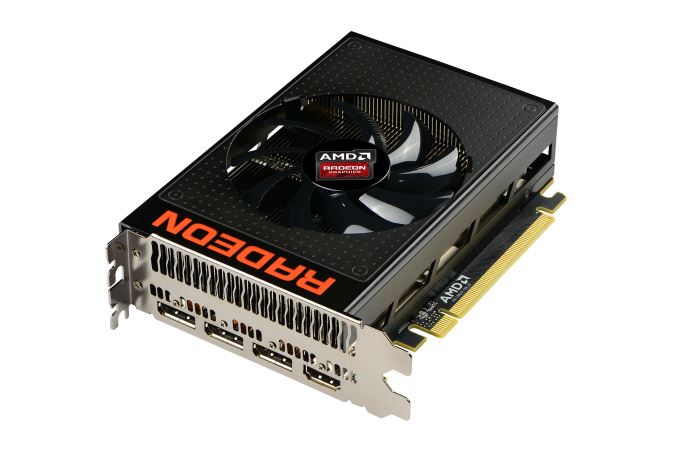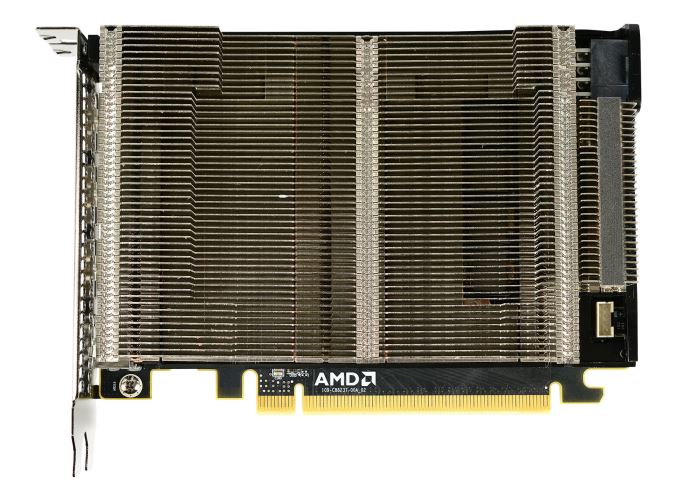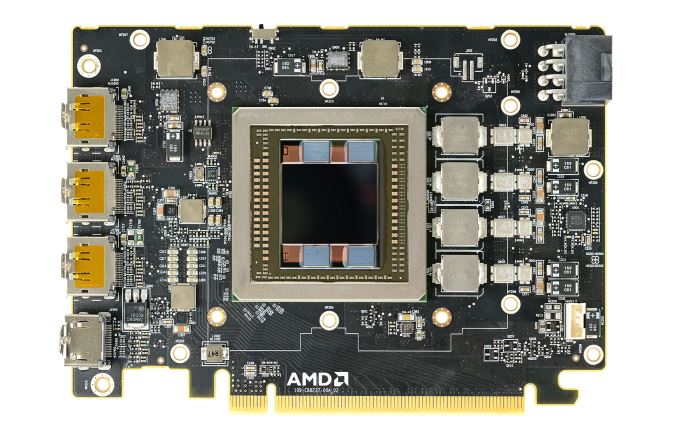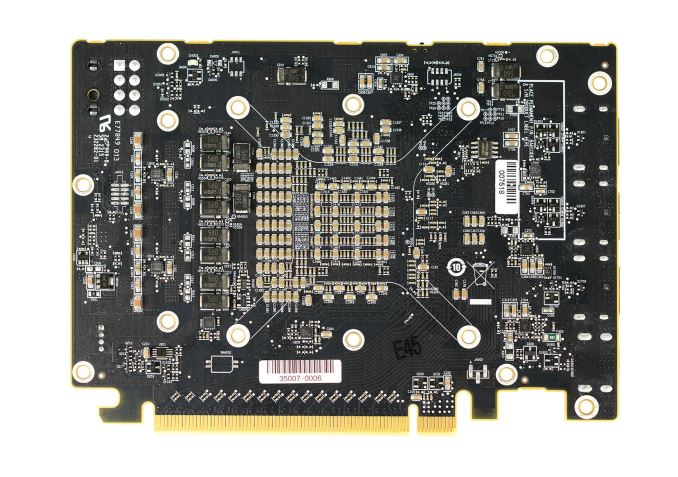The AMD Radeon R9 Nano Review: The Power of Size
by Ryan Smith on September 10, 2015 8:00 AM ESTMeet The Radeon R9 Nano
6 inch video cards are by no means a new thing in the GPU space, however these are traditionally lower-end products that need neither a large cooler nor an extensive power delivery system. As a result the R9 Nano is something of an interesting aberration, packing a lot more power and a lot more technology into half a foot of video card than what we normally see.
Starting as always from the top, the R9 Nano measures 6” long, which is actually a bit shorter than the full length the Mini-ITX standard allows. Responsibility for cooling the card falls to the R9 Nano’s new open air cooler, an aggressive design that has been specifically tailored to allow the card to effectively dissipate 175W of heat in such a small space.
The overall design of the R9 Nano’s cooler is best described as a combination open-air and half-blower hybrid. The design is technically open-air, employing a single axial fan to cool the card. However with only a single fan AMD has been able to align the heatsink fins horizontally and then place the fan in the center of the heatsink. The end result is that roughly half of the heat produced by the card is vented outside of the case, similar to a full blower, while the other half of the heat is vented back into the case. This reduces (though doesn’t eliminate) the amount of hot air being recycled by the card.
The heatsink itself is composed of aluminum and runs virtually the entire length of the card. This is technical a two-piece heatsink, with the primary heatsink composing the bulk of the card, while a much smaller secondary heatsink it found towards the far end of the card and mounted on top of a heatpipe.
Drilling down, we find that the primary heatsink is fed by a combination vapor chamber and heatpipe design. A copper vapor chamber serves to draw heat away from the Fiji GPU and HBM stacks, and then heatpipes are used to better distribute heat to the rest of the heatsink. The use of a vapor chamber in the R9 Nano makes a lot of sense given the fact that vapor chambers are traditionally the most efficient heatsink base type, however the R9 Nano is also unique in that we typically don’t see vapor chambers and heatpipes used together. Other designs such as the high-end GeForce series use a single large vapor chamber across the entire heatsink base, so among reference cards at least the R9 Nano stands alone in this respect. In this case given AMD’s design goals for size and noise, a vapor chamber will play a big part in helping the small card effectively and quietly dissipate 175W.
As for the physical PCB itself, as we can see AMD made it a relatively packed card in order to get the R9 Nano down to 6 inches. Compared to the R9 Fury X reference board, the biggest change here is that AMD has removed a fair bit of power circuitry to save space. By our count there are 4 VRM phases to feed the Fiji GPU, as opposed to the 6 found on R9 Fury X. Power delivery is handled by a single 8-pin PCIe power socket, which is becoming increasingly common, replacing the 2x 6-pin setup for 150W-225W cards.
Meanwhile to further shrink the overall PCB footprint, AMD has moved some of the remaining power delivery circuitry to the back of the card. The front of the card still contains the inductors and heat-sensitive MOSFETs, while a number of capacitors are on the rear of the card (and is why you won’t find a backplate).
Finally, for display I/O R9 Nano is unchanged from R9 Fury X. This means we’re looking at a DVI-free design, with 3x DisplayPort 1.2 and 1x HDMI 1.4 port all along a single row of the I/O bracket. Buyers looking to put together HTPCs will want to be especially mindful of the HDMI 1.4 port; while it's not necessarily a deal-breaker, it does mean that the R9 Nano can't fully drive 4Kp60 TVs, which are slowly but surely becoming more common.
Overall AMD is rather confident in their design for the R9 Nano. The heatsink is built to efficiently dissipate more heat than the 175W the card requires (despite the small size), and as a result we never see the R9 Nano thermally throttle under normal operation. The card’s thermal throttle point is 85C, and in our testing the card never passed 75C, exactly as AMD promised us. What ends up limiting the R9 Nano’s performance then is exactly as expected: the power throttling.
















284 Comments
View All Comments
SeanJ76 - Thursday, September 10, 2015 - link
AMD is about to claim bankruptcy......silverblue - Friday, September 11, 2015 - link
Somebody just bought 20% of their shares. If you want them to file chapter 11, be a little more patient, grasshopper.close - Thursday, September 10, 2015 - link
Guess Nvidia is dead to you as a brand also for the whole 3.5GB issue (which we all know how well was handled). That leaves you with the Intel iGPU. But some people have the little fetish of being crapped on from a single direction.Saying "they're dead to me as a brand" is the same as saying "from now on I will disconsider their offerings even if they may be better value or simply better". And this does you no favors, trust me.
Azix - Thursday, September 10, 2015 - link
Does AMD not give out review guidelines? It seems that's something nvidia does. eg when the Ashes benchmark came out they told review sites not to use AA, a lot didn't. Maybe AMD figures some sites will ignore this guidance. eg. if they said nano was not to be compared to the 980ti or fury X and was a niche product for small cases, some sites like kitguru would still compare it to a 980ti rather than the closest mini GPUgw74 - Thursday, September 10, 2015 - link
It is none of the companies' business how their products are reviewed. Their only business to make good products. Anyone can compare anything they like to anything else and benchmark it using anything they want.ianmills - Thursday, September 10, 2015 - link
I wish it was but even anandtech falls in line with this and overuses company's marketing terms to make it hard to compare to previous generationsRyan Smith - Thursday, September 10, 2015 - link
Interesting. I'm certainly not trying to "fall in line" or otherwise use specific marketing terms, so if I'm doing that then it's unplanned. What terms have I been using, so that I can watch out for it in the future?Alexvrb - Friday, September 11, 2015 - link
Yeah! Tell em gw! Same with automotive testing. No guidelines, no rules! If they loan you a 1-ton pickup truck and you compare it to sports cars on a twisty track, bash the truck and give it a horrible review for "poor handling vs 500K exotic sports cars" - well that's none of their business!/sarcasm
gw74 - Sunday, September 13, 2015 - link
I am talking about no guidelines or rules from the manufacturers, genius. That obviously does not mean the reviewing party does not use its brain to compare and test in a sensible way. You absolute clown.Kutark - Thursday, September 10, 2015 - link
They're not demands, they're just telling people ahead of time if there is a particular game that is exhibiting issues with a particular setting. Which especially if its an in progress issue they're debugging, doesn't paint a good picture of the product, and only serves to give ammunition for detractors to cherry pick data points to use in their crusades.